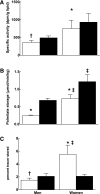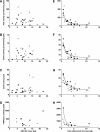Free fatty acid storage in human visceral and subcutaneous adipose tissue: role of adipocyte proteins
- PMID: 21810594
- PMCID: PMC3161316
- DOI: 10.2337/db11-0219
Free fatty acid storage in human visceral and subcutaneous adipose tissue: role of adipocyte proteins
Abstract
Objective: Because direct adipose tissue free fatty acid (FFA) storage may contribute to body fat distribution, we measured FFA (palmitate) storage rates and fatty acid (FA) storage enzymes/proteins in omental and abdominal subcutaneous fat.
Research design and methods: Elective surgery patients received a bolus of [1-(14)C]palmitate followed by omental and abdominal subcutaneous fat biopsies to measure direct FFA storage. Long chain acyl-CoA synthetase (ACS) and diacylglycerol acyltransferase activities, CD36, fatty acid-binding protein, and fatty acid transport protein 1 were measured.
Results: Palmitate tracer storage (dpm/g adipose lipid) and calculated palmitate storage rates were greater in omental than abdominal subcutaneous fat in women (1.2 ± 0.8 vs. 0.7 ± 0.4 μmol · kg adipose lipid(-1) · min(-1), P = 0.005) and men (0.7 ± 0.2 vs. 0.2 ± 0.1, P < 0.001), and both were greater in women than men (P < 0.0001). Abdominal subcutaneous adipose tissue palmitate storage rates correlated with ACS activity (women: r = 0.66, P = 0.001; men: r = 0.70, P = 0.007); in men, CD36 was also independently related to palmitate storage rates. The content/activity of FA storage enzymes/proteins in omental fat was dramatically lower in those with more visceral fat. In women, only omental palmitate storage rates were correlated (r = 0.54, P = 0.03) with ACS activity.
Conclusions: Some adipocyte FA storage factors correlate with direct FFA storage, but sex differences in this process in visceral fat do not account for sex differences in visceral fatness. The reduced storage proteins in those with greater visceral fat suggest that the storage factors we measured are not a predominant cause of visceral adipose tissue accumulation.
Figures



References
-
- Kissebah AH, Krakower GR. Regional adiposity and morbidity. Physiol Rev 1994;74:761–811 - PubMed
-
- Fox CS, Massaro JM, Hoffmann U, et al. Abdominal visceral and subcutaneous adipose tissue compartments: association with metabolic risk factors in the Framingham Heart Study. Circulation 2007;116:39–48 - PubMed
-
- Manolopoulos KN, Karpe F, Frayn KN. Gluteofemoral body fat as a determinant of metabolic health. Int J Obes (Lond) 2010;34:949–959 - PubMed
-
- Guo ZK, Hensrud DD, Johnson CM, Jensen MD. Regional postprandial fatty acid metabolism in different obesity phenotypes. Diabetes 1999;48:1586–1592 - PubMed
-
- Burguera B, Proctor DN, Dietz N, Guo Z, Joyner MJ, Jensen MD. Leg free fatty acid kinetics during exercise in men and women. Am J Physiol Endocrinol Metab 2000;278:E113–E117 - PubMed
Publication types
MeSH terms
Substances
Grants and funding
LinkOut - more resources
Full Text Sources
Medical
Research Materials
Miscellaneous

